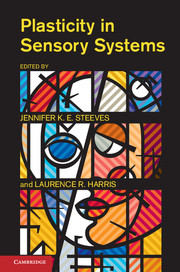Book contents
- Frontmatter
- Contents
- List of Contributors
- 1 Plasticity in Sensory Systems
- I VISUAL AND VISUOMOTOR PLASTICITY
- II PLASTICITY IN CHILDHOOD
- 5 Human Visual Plasticity: Lessons from Children Treated for Congenital Cataracts
- 6 Living with One Eye: Plasticity in Visual and Auditory Systems
- 7 Building the Brain in the Dark: Functional and Specific Crossmodal Reorganization in the Occipital Cortex of Blind Individuals
- 8 Crossmodal Plasticity in Early Blindness
- III PLASTICITY IN ADULTHOOD AND VISION REHABILITATION
- Author Index
- Subject Index
- References
5 - Human Visual Plasticity: Lessons from Children Treated for Congenital Cataracts
from II - PLASTICITY IN CHILDHOOD
Published online by Cambridge University Press: 05 January 2013
- Frontmatter
- Contents
- List of Contributors
- 1 Plasticity in Sensory Systems
- I VISUAL AND VISUOMOTOR PLASTICITY
- II PLASTICITY IN CHILDHOOD
- 5 Human Visual Plasticity: Lessons from Children Treated for Congenital Cataracts
- 6 Living with One Eye: Plasticity in Visual and Auditory Systems
- 7 Building the Brain in the Dark: Functional and Specific Crossmodal Reorganization in the Occipital Cortex of Blind Individuals
- 8 Crossmodal Plasticity in Early Blindness
- III PLASTICITY IN ADULTHOOD AND VISION REHABILITATION
- Author Index
- Subject Index
- References
Summary
At birth, infants can see only large objects of high contrast located in the central visual field. Over the next half year, basic visual sensitivity improves dramatically. The infant begins to perceive the direction of moving objects and stereoscopic depth, and to integrate the features of objects and faces. Nevertheless, it takes until about 7 years of age for acuity and contrast sensitivity to become as acute as those of adults and into adolescence for some aspects of motion and face processing to reach adult levels of expertise.
An important developmental question is whether, and to what extent, the improvements in vision during normal development depend on normal visual experience. To find out, we have taken advantage of a natural experiment: children born with dense, central cataracts in both eyes that block all patterned visual input to the retina. The children are treated by surgically removing the cataractous lenses and fitting the eyes with compensatory contact lenses that allow the first focused patterned visual input to reach the retina. In the studies summarized in this chapter, the duration of deprivation – from birth until the fitting of contact lenses after surgery – ranged from just a few weeks to most of the first year of life. In other cases, the child began with apparently normal eyes but developed dense bilateral cataracts postnatally that blocked visual input. As in the congenital cases, the cataractous lenses were removed and the eyes fitted with contact lenses.
- Type
- Chapter
- Information
- Plasticity in Sensory Systems , pp. 75 - 93Publisher: Cambridge University PressPrint publication year: 2012
References
- 1
- Cited by



